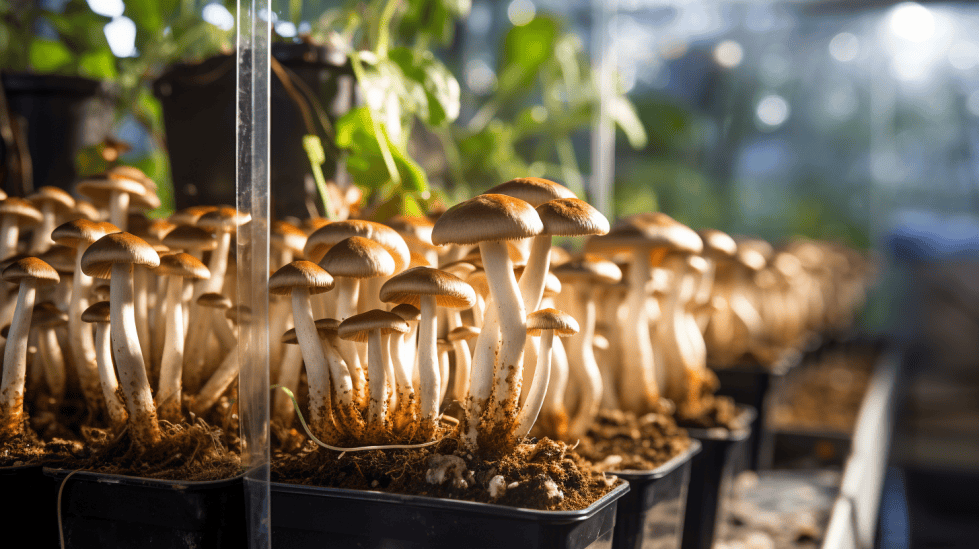How to Build a Mushroom Grow Room
Growing mushrooms at home can be a rewarding and fascinating endeavor, especially for those who enjoy consuming various types of mushrooms. Building a mushroom grow room is crucial to get started, as it provides the right conditions and environment suitable for the mushrooms’ growth. Before diving into the specifics of building a mushroom grow room, it’s important to understand the basics of mushroom cultivation and the factors that affect their growth.
There are many varieties of mushrooms one can grow, each requiring specific conditions, such as temperature, humidity, and growing mediums. By selecting an appropriate growing medium and understanding how to prepare spawn, you increase the chances of a successful harvest. As you venture into building your own mushroom grow room, it’s essential to maintain a clean and well-balanced environment. This includes proper lighting and arrangement of fruiting blocks, along with constant vigilance to ensure the ideal conditions for mushroom growth are met.
Key Takeaways
- Building a mushroom grow room is essential for creating an optimal environment for growth and harvest.
- Understanding the basics of mushroom cultivation, including selecting a suitable variety and preparing spawn, contributes to successful yields.
- Balancing environmental conditions, lighting, and cleanliness are crucial factors in ensuring the fruitful cultivation of mushrooms.
Understanding Mushroom Basics
Before diving into building a mushroom grow room, it’s important for me to understand the basics of mushroom cultivation. The type of mushroom, species, and specific requirements for growth are crucial factors to consider when setting up a space for mushroom cultivation.
There are various types of mushrooms that one may choose to grow, including popular species such as oyster, shiitake, and button mushrooms. Each mushroom species has its own unique cultivation requirements, including temperature, humidity, and substrates. So, in order to create a successful grow room, it’s essential to have a basic understanding of the chosen mushroom type.
Mushroom cultivation involves following a series of steps to ensure the healthy growth and development of the fungus. The process typically begins with the inoculation of a sterile substrate, such as grain or sawdust, with mushroom spores or mycelium. The inoculated substrate is then incubated under specific conditions to promote the growth of the mycelium, which eventually colonizes the entire substrate.
Once the substrate is fully colonized, it’s time to induce fruiting, which involves altering the temperature, humidity, and lighting conditions to stimulate the development of mushroom fruiting bodies. This is where the grow room comes into play, providing a controlled environment for the mushrooms to grow and thrive.
Creating a suitable environment for mushroom cultivation requires attention to detail. Managing factors such as temperature, humidity, and lighting play a crucial role in ensuring the success of the grow room. For example, oyster mushrooms prefer temperatures between 60-75°F, while shiitakes grow best at temperatures ranging from 50-80°F.
Humidity also plays a vital role in the growth of mushrooms. Most mushrooms require a high level of humidity, around 80-95%, to thrive. Consistent and adequate humidity levels can be achieved through various methods, such as the use of humidifiers, misting systems, or passive techniques like placing trays of water in the grow room.
Lighting is another essential factor for mushroom cultivation, as it influences the direction of growth, color, and quality of the mushroom fruiting bodies. While mushrooms don’t rely on sunlight for photosynthesis like plants, they still require certain light exposure for proper growth. A simple setup with a diffused 6500K light source on a 12-hour timer can provide the necessary illumination for most mushroom species.
In conclusion, it’s important for me to remember that having a clear understanding of the chosen mushroom type and its specific growth requirements will help increase the success and efficiency of the mushroom grow room.
Choosing the Right Variety of Mushroom
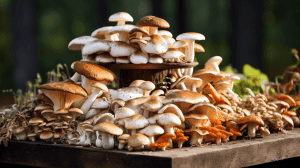
When building a mushroom grow room, choosing the appropriate mushroom variety is essential. In my experience, some popular choices for beginners include oyster mushrooms, shiitake mushrooms, and white button mushrooms. Each variety has specific growing requirements, so understanding their needs will ensure a successful grow.
Oyster mushrooms (Pleurotus ostreatus) are one of the easiest varieties to grow at home. They adapt well to diverse growing conditions and produce a high yield. These mushrooms can grow on various substrates, such as straw, coffee grounds, or wood chips, making them a versatile choice. Furthermore, oyster mushrooms are tasty and highly nutritious.
Shiitake mushrooms are another favorite due to their delicious taste and numerous health benefits. They require a bit more attention when it comes to growing conditions, but with proper care, they can thrive. Shiitake mushrooms grow best on hardwood logs or sawdust blocks, and maintaining the right temperature and humidity levels is crucial for their success.
On the other hand, white button mushrooms are widely known and commonly consumed. Growing them can be more challenging as they need a specific environment that includes a cooler initial incubation period followed by precise temperature and humidity adjustments. White button mushrooms primarily grow on manure or straw-based composts, making them slightly different from oyster and shiitake mushrooms in terms of substrates.
In conclusion, consider the different species’ growing requirements, your available resources, and your taste preferences when choosing the right mushroom variety for your grow room. By understanding the nuances of each mushroom type, you can maximize your chances of a successful and rewarding harvest.
Selecting Appropriate Growing Medium
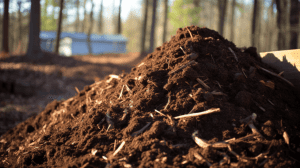
When it comes to building a mushroom grow room, one of the most important decisions is selecting the right growing medium. In my experience, there are several options to choose from, but the best medium will depend on the species of mushroom you’re growing and your specific growing conditions.
Hardwood sawdust is a commonly used growing medium for many mushrooms, especially for wood-loving species like Shiitake and Oyster mushrooms. It provides a good balance of nutrients and texture for these fungi to thrive. Additionally, it’s usually an affordable and readily available option for most growers.
Mushroom compost, also known as spent mushroom substrate, is another popular choice for growing mushrooms. This compost is usually made from a mix of organic materials like straw, hay, gypsum, corn cobs, and sometimes even horse manure. It has been previously sterilized and used to grow mushrooms, so it’s packed with nutrients that will help your mushrooms thrive. Remember that this medium might not be suitable for all types of mushrooms, so it’s essential to ensure compatibility with your chosen species.
Wood chips can also serve as a suitable growing medium for mushrooms, especially for outdoor cultivation. They provide a more natural growing environment for wood-loving species and can help to retain moisture in the grow area. However, wood chips may not provide enough nutrients for some mushroom types, so mixing them with another medium like hardwood sawdust or mushroom compost is recommended.
When selecting an appropriate growing medium, I always consider the specific requirements of the mushroom species I’m cultivating. It’s essential to research the preferred growing mediums for your chosen mushroom species and adjust your choice accordingly. A successful mushroom grow room starts with the right foundation, and selecting the most proper growing medium will set your mushrooms up for success.
Spawn Preparation
Preparing the mushroom spawn is a crucial step in creating your mushroom grow room as it involves providing a good foundation for the mycelium to grow and later form healthy mushrooms. Firstly, you need to choose your desired mushroom spawn, which can be purchased from mushroom suppliers or created from your own mushroom cultures.
When working with spawn bags, ensure that they are of appropriate size to hold your chosen grain or substrate. Once you have the bags ready, you’ll need to ensure all tools and containers used for the spawn preparation are clean and sterilized to avoid potential contaminants. I recommend using a pressure cooker to sterilize your grain or substrate, as it can effectively eliminate any dangerous bacteria or pathogens.
Before inoculating the grain, make sure it is at the optimal moisture level. You can achieve this by rinsing the grain, soaking it for about 12-24 hours, and then simmering it for 15-20 minutes, followed by draining and drying. When filling the spawn bags, it’s important to maintain a balance between not packing the grain too tightly and ensuring enough is available for mycelium to colonize.
Once the spawn bags are filled and sealed, it’s time to inoculate them with your chosen mushroom spawn. It’s important to practice good sterile technique when handling the spawn and syringe to minimize contamination. After inoculation, the spawn bags should be placed in a dark, temperature-controlled environment to incubate. The temperature during incubation should be ideally between 65-70°F (18-21°C) and it usually takes 4-8 weeks for the mycelium to fully colonize the grain.
During the spawn run, it’s essential to periodically check the growth of mycelium and monitor for any potential signs of contamination. The spawn run is complete when the entire surface of the grain has been colonized by white, fluffy mycelium. At this stage, the fully colonized spawn bags can be used to inoculate your main mushroom substrate in the grow room.
To sum up, spawn preparation is a significant part of building a successful mushroom grow room. Following these steps carefully and using sterile techniques will ensure healthy mycelium growth and, ultimately, bountiful mushroom harvests.
Creating a Mushroom Grow Room
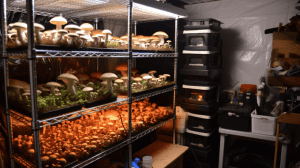
When building my mushroom grow room, I found it essential to consider the specific needs of the mushrooms I planned to cultivate. Different species thrive under different conditions, so understanding these requirements helps ensure success.
First and foremost, I chose an appropriate grow area for my mushrooms. A large and clean space is necessary for proper mushroom cultivation, as it provides ample room for grow tents or grow chambers. I needed approximately 2000 Sq. Ft. to accommodate shelves, equipment (darkroom light, fans, humidifiers), mycelium, and the harvested mushrooms. The GroCycle article I read mentioned that a mushroom fruiting chamber is an enclosed space that mimics the natural environment for mushrooms, helping them grow successfully.
When selecting the right grow tent or grow chamber, I considered the size of my growing space and the specific needs of the mushrooms. The chosen grow tent provided a controlled environment, allowing me to manage temperature and humidity levels easily. I also ensured that my setup had proper air circulation, as fresh air exchange is crucial for healthy mushroom growth, according to the Mossy Creek Mushrooms blog.
For my incubation room, I focused on maintaining a dark and controlled environment to support the mycelium’s growth. The temperature range I aimed for was 10°C – 20°C, and a humidity level between 80% – 95%, as suggested by Total Gardener. Proper insulation and climate walls helped me achieve these optimal conditions in both the incubation room and the grow area. Additionally, I made sure to install an adjustable exhaust fan to replace all the air in the room within 2 minutes when running at full speed.
In conclusion, understanding the specific needs of the chosen mushroom species, having an appropriate grow area and grow tent, maintaining proper climate conditions, and providing adequate fresh air are all crucial steps in creating a successful mushroom grow room. With these factors in mind, I was able to establish a thriving environment for my mushroom cultivation project.
Balancing the Environmental Conditions
When building a mushroom grow room, it’s essential to balance the environmental conditions. I’ve found that mushrooms require a specific combination of fresh air exchange, humidity levels, temperature regulation, and air flow in order to flourish.
One of the main factors that contributes to successful mushroom growth is maintaining high humidity. Ideally, the relative humidity in the grow room should be between 70% and 90% to prevent unwanted bacterial and mold growth. I achieve this by using a humidity controller to monitor and maintain the humidity levels. Additionally, cool mist humidifiers can be utilized to ensure that the environment stays moist and conducive for the mushrooms’ development.
Temperature regulation is another crucial element for optimal mushroom growth. Depending on the mushroom species, I recommend maintaining a specific temperature range suitable for that species in the grow room. It is essential to have a good heating and cooling system, as well as accurate temperature sensors to help monitor and adjust the room’s temperature.
Fresh air exchange is vital for providing the mushrooms with the necessary oxygen they need to grow. It also helps prevent the buildup of CO2. I ensure a proper airflow system, such as using an exhaust fan and air intake, to promote healthy mushroom growth. Remember to avoid creating direct drafts on the mushrooms, as they can dry them out.
In conclusion, balancing the environmental conditions in a mushroom grow room requires attention to the fresh air exchange, humidity levels, temperature regulation, and air flow. By maintaining these optimal conditions, I am able to cultivate healthy and fruitful mushrooms.
The Importance of Lighting

As someone who has experience in growing mushrooms, I can confidently say that proper lighting plays a crucial role in the process. Many people assume that mushrooms grow in the dark, but in reality, they need a certain amount of light to thrive. With the right light source, you can help ensure healthy, abundant mushroom growth.
The first thing to consider is that direct sunlight should be avoided. Mushrooms do not need bright light like many plants, and too much sunlight can harm them. Overexposure to direct sunlight may cause the mushrooms to dry out or fail to grow properly. Instead, choose an indirect or artificial light source that offers a more controlled environment.
When selecting a light source, consider LED lights or fluorescent tubes for your mushroom grow room. These types of lights are energy-efficient and produce less heat, which helps maintain the optimal temperature for mushroom growth. For instance, positioning an LED light source at the top of the grow chamber will provide even, diffused lighting throughout the space.
Proper lighting isn’t just about providing enough light – it also involves setting up the right schedule or duration. My experience has taught me that mushrooms typically require around 12 hours of light per day, followed by 12 hours of darkness. This mimics their natural growing conditions, allowing them to develop strong and robust fruiting bodies.
In summary, paying attention to lighting in a mushroom grow room can greatly impact the success of your cultivation process. Avoid direct sunlight and opt for controlled lighting sources like LEDs or fluorescent tubes. Finally, ensure that you maintain a consistent 12-hour light/dark cycle. By following these guidelines, I believe you will notice a significant improvement in your mushrooms’ growth and overall quality.
Arranging Fruiting Blocks
When I was setting up my mushroom grow room, one crucial step was arranging the fruiting blocks. Fruiting blocks are essential for supporting the growth of my mushrooms’ fruiting bodies, and proper placement is key. In this section, I will share my process of arranging fruiting blocks to create an optimal fruiting environment.
Firstly, I prepared my fruiting chamber, ensuring that it had the right humidity, temperature, and lighting conditions. To achieve this, I used fans, humidifiers, and heaters as needed according to a guide. My chamber also had walls that could retain moisture, which is important for mushroom growth.
Next, I focused on the fruiting blocks themselves. I used a mixture of sawdust and soy hulls as my substrate based on a recipe I found. The sawdust soaks up water more slowly, while soy hulls absorb it faster, making them a great combination as a mushroom block.
Once my fruiting blocks were ready, I placed them evenly throughout my fruiting chamber. I made sure to allow enough space between them for proper air circulation. This is essential for minimizing the risk of contamination and promoting the growth of healthy fruiting bodies.
I monitored the conditions in my fruiting room daily and adjusted the humidity, temperature, and lighting as needed. This constant attention helped my mushrooms thrive and grow to their full potential.
In summary, arranging fruiting blocks in the right fruiting chamber and giving them ample space is critical for the growth and health of mushroom fruiting bodies. By following these steps and maintaining optimal conditions, I was able to successfully cultivate a variety of mushrooms in my fruiting room.
Ensuring Proper Cleanliness
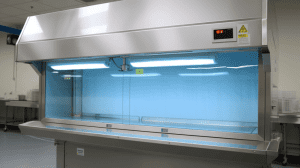
When it comes to building a mushroom grow room, one of the most crucial aspects is ensuring proper cleanliness. From my experience, maintaining a sterile environment is essential for successful mushroom cultivation.
To achieve clean air, installing a flow hood is a crucial step. A flow hood works by pushing sterile, filtered air into the grow room, which helps prevent airborne contaminants from entering and spoiling the process. By having one of these in place, I can effectively minimize the risk of contamination.
In addition to clean air, it’s vital to use distilled water throughout the growing process. Distilled water is free from any contaminants or impurities, making it ideal for use in a sterile environment. By using it for misting, mixing substrates, or hydrating mycelium, I ensure that my mushroom grow room remains free of potential contaminants.
To further establish a hygienic environment, I always work with sterilized tools and equipment, such as petri dishes. Sterilizing tools with heat or chemical methods eliminates any lingering contaminants, which is particularly important when handling delicate mycelium cultures. By consistently using sterilized equipment, I significantly decrease the chances of microbial contamination in the grow room.
As a cultivator, it’s crucial to adopt proper personal hygiene practices as well. I make it a point to wear clean clothes, gloves, and a face mask to prevent the spread of contaminants from myself to the growing environment.
In summary, maintaining a clean and sterile environment is essential for a successful mushroom grow room. By implementing clean air circulation through a flow hood, using distilled water, sterilizing equipment, and ensuring proper personal hygiene, I can confidently create the ideal conditions for mushroom cultivation.
Setting Up the Ideal Environment
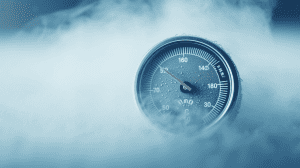
I know that creating the ideal environment is crucial for successful mushroom cultivation. Providing the right conditions helps mushrooms thrive and produce a bountiful harvest.
In my experience, cooler temperatures are essential for most mushroom varieties. Keeping the grow room temperature between 10°C and 20°C is typically ideal. This can be adjusted based on the specific mushroom species being grown, as some may prefer slightly higher temperatures. I make sure to monitor and adjust the temperature accordingly to keep my mushrooms happy and growing.
Humidity plays a significant role in mushroom development. I’ve found that maintaining a humidity level of 80% to 95% is optimal for most mushroom species. To achieve this, I use an ultrasonic humidifier in my grow room as a reliable way to ensure consistent humidity. Cyclic fluctuations in humidity between 70% and 90% can also create a more natural environment for the mushrooms, helping them grow even better.
Another essential aspect of the ideal environment is air exchange. Proper ventilation prevents the accumulation of stale air and allows fresh air to circulate within the grow room. I usually ensure there’s adequate airflow by installing an exhaust fan and regularly checking its effectiveness.
Lighting in the grow room is important for initiating the fruiting process in mushrooms. While it’s crucial not to directly expose mushrooms to sunlight, low-intensity indirect light is necessary for their growth. I use LED lights that provide a sufficient amount of light without generating excess heat.
In conclusion, the ideal environment for a mushroom grow room revolves around maintaining the right conditions such as cooler temperatures, high humidity, proper air exchange, and appropriate lighting. By carefully considering these factors and adjusting them based on the specific mushroom species, achieving a thriving mushroom cultivation is within reach. Happy growing!
Steps to Cultivate Your Own Mushrooms
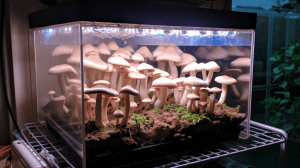
I’m always excited to share my knowledge on mushroom cultivation, so let’s dive into the essential steps for setting up a successful grow room for your own fresh mushrooms. Remember, the most important thing is being consistent with best practices to have a thriving mushroom production.
Firstly, I make sure to create a sterile environment for my growing mushrooms. Contamination can quickly ruin an entire batch, so cleanliness is crucial. I sanitize all equipment, surfaces, and my hands before getting started, and maintain a clean grow room throughout the process. In my experience, a well-ventilated area with enough room for air circulation can help prevent mold and bacterial growth.
Next, I choose the right substrate for the specific species of mushroom I’m growing. The substrate is the material where the mushrooms feed and grow. For instance, oyster mushrooms thrive on a mixture of coffee grounds and straw, while shiitake mushrooms prefer hardwood sawdust. Doing a little research on the ideal substrate for your chosen mushroom species can greatly enhance your success rate.
Now comes the inoculation process. I usually prefer to mix my mushroom spawn (mycelium) directly into the substrate, ensuring a seamless blend. If you’re using a mushroom growing kit, the spawn will come pre-inoculated, so all you have to do is follow the kit’s instructions. The key is to spread the spawn evenly throughout the substrate to enhance colonization.
After inoculation, it’s vital to control the environmental factors that affect mushroom growth. For my grow room, I closely monitor temperature, humidity, and lighting. Each mushroom species has its own preferred temperature and humidity levels. For instance, shiitake mushrooms grow best at temperatures between 50-60°F, while oyster mushrooms prefer 60-80°F. A humidifier and a thermostat can help maintain these conditions to promote optimal growth.
Lighting is another essential aspect of creating a perfect mushroom grow room. In my set-up, I provide natural light or use indirect fluorescent lighting. Contrary to popular belief, mushrooms do require some light to grow, but they don’t need intense or direct light like plants do. A consistent 12-hour light cycle ensures the right balance for mushroom development.
I always keep an eye out for signs of growth, like the emergence of small mushroom pins. This usually happens within a week or two after inoculation. Once they start growing, it’s important to maintain the ideal conditions and continue misting the substrate with water to keep it moist.
By following these steps, I’ve achieved a successful mushroom cultivation process, and I’m confident that your own mushroom production will flourish with these best practices. Just remember to be patient, diligent, and always strive to learn more about what works best for your specific mushroom species.
Choosing the Right Tools
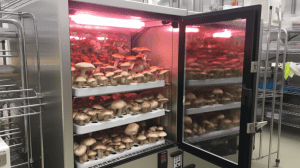
When I’m setting up a mushroom grow room, choosing the right tools is crucial for success. To maintain optimal growing conditions, some essential items I find necessary are a spray bottle, PVC pipes, a humidity controller, and an exhaust fan.
I like to use a spray bottle to mist the grow room, ensuring the humidity levels stay within the ideal range. A spray bottle also allows for targeted water distribution, making it easy for me to avoid oversaturating the growing medium.
PVC pipes are another essential for my mushroom grow room setup. They are versatile and can be used for constructing a shelving system or as a framework for a humidity tent. The ease of cutting and joining PVC pipes makes it a preferred material for customizing my grow room layout.
A humidity controller is vital in maintaining the right environment for my mushrooms to flourish. It helps me to automate the humidification process, reducing the need for constant manual adjustments. The controller monitors the humidity in the grow room and activates a humidifier or dehumidifier when needed to maintain the desired levels.
Lastly, an exhaust fan plays a crucial role in air circulation in my grow room. Proper airflow ensures fresh air exchange, which is necessary for healthy mushroom growth. It also helps prevent the buildup of stale air and minimizes the risk of contamination.
By selecting and utilizing these tools effectively, I can create a suitable environment for my mushroom grow room, leading to healthy and bountiful production.
Best Ways to Grow Mushrooms
Growing mushrooms at home can be a fulfilling and productive experience, yielding the best results when you create an optimal environment for their growth. Let me share some tried and tested methods that have helped me achieve a flourishing mushroom grow room.
Firstly, it’s essential to maintain a clean, sterile environment to prevent contamination. I found that using a non-porous hard floor and walls that can be easily cleaned prevents any unwanted microorganisms from affecting the mushrooms’ growth and quality. Proper drainage within the flooring also helps manage water levels well. A good source confirms the same.
Temperature and humidity control are critical for mushrooms’ success. Depending on the species, different temperatures may be optimal for growth, but generally, 65 to 75°F (18 to 24°C) works well. I discovered that having a reliable heating and cooling system was an investment with excellent returns, as it allowed precise temperature control. Humidity should be maintained around 80-90% for most species, and it can be controlled effectively with a humidifier.
Proper lighting is another factor that can make a difference in your mushroom grow room. Although mushrooms aren’t photosynthetic, they still require some light for the fruiting process. I found that using LED lights on a 12-hour cycle provided the required energy without generating excessive heat.
One tried and tested technique to maximize mushroom production is creating a well-structured fruiting chamber that fosters humidity and airflow. I built mine by following a step-by-step guide that facilitated understanding the process.
Here are some key elements I considered for my mushroom grow room:
- Sterile conditions
- Humidity and temperature control
- Proper lighting
- Efficient fruiting chamber design
Incorporating these elements into my mushroom grow room has not only resulted in better-quality mushrooms but has also significantly increased their production. By following these recommendations, your mushroom growing journey can be a rewarding experience.
Commercial vs. Home Growing

As a mushroom enthusiast, I’ve come to appreciate the differences between commercial and home growing environments. When it comes to establishing a successful mushroom cultivation space, there are several aspects to consider, including scale, investment, equipment, and techniques. In this section, I will discuss the key differences between commercial and home mushroom growing.
Commercial mushroom growers typically operate on a larger scale than home growers, often producing mushrooms for sale at markets, restaurants, or other food retailers. This typically means a more extensive grow area, higher potential yields, and increased investment in infrastructure and equipment. For instance, commercial growers may choose to implement CEA mushroom systems that provide consistent temperatures, automate humidity and airflow control, and enhance sanitation measures to minimize chances of contamination.
On the other hand, home growers usually focus on small-scale production for personal use or sharing with friends and family. A smaller grow space requires less investment in equipment and set-up costs. For example, creating a mushroom fruiting chamber can be done relatively inexpensively by repurposing items you likely already have at home, such as plastic containers or storage bins. Home growers can achieve ideal growing conditions by maintaining proper humidity, temperature, and air circulation in their grow rooms, but without the need for commercial-level automation or monitoring.
When it comes to the techniques used, both commercial and home growers can utilize similar growing methodologies, such as the use of sterile substrates, spawn, and starting cultures. However, commercial growers may often employ more advanced methods requiring special equipment, like autoclaves or laminar flow hoods, to ensure the highest level of sanitation and control over growing conditions.
Starting a small mushroom farm at home or launching an urban farm to supplement your income is an attainable goal for many aspiring mushroom growers. It’s essential to consider your objectives, available resources, and desired level of production when choosing between commercial and home mushroom growing. Remember that the level of time and energy investment will differ significantly between professional and personal operations, but with dedication and knowledge, it’s possible to create a thriving mushroom cultivation space, no matter the scale.
Understanding Different Stages of Growing
Growing mushrooms is truly a fascinating process. It begins with the foundation of mushroom growth: the mycelium. Mycelium refers to the thread-like network of white filaments that become the foundation for mushroom growth. Not only do I have to nurture the mycelium but also pay close attention throughout the entire growing process.
In my experience, one of the most important aspects for mushroom cultivation is selecting the appropriate strain, as it directly influences the entire growth process and the final outcome. Different mushroom types have varying growth requirements, so considering the intended outcome, from culinary to medicinal purposes, is crucial. I found detailed information on strain selection here.
Next comes the substrate preparation, which refers to the material that the mushroom mycelium colonizes and extracts nutrients from. Common substrates include grains, straw, and wood. Choosing the right substrate is essential, as it directly influences the health of the white mycelium. The more nutrient-rich and appropriate the substrate, the better the mycelium will grow.
Inoculation involves introducing the mushroom mycelium to the prepared substrate. This step is crucial and requires sterilization to prevent contamination. Using proper sterile techniques, I carefully transfer the mycelium spawn to the substrate.
The incubation stage begins as the mycelium colonizes the substrate. During this period, I ensure a consistent temperature and humidity level, enabling the mycelium to grow optimally. Typically, mycelium can colonize in a matter of days to weeks, depending on factors like the strain, substrate type, and environmental factors.
Once the substrate is fully colonized, the initiation stage starts. At this stage, I manipulate environmental factors like humidity, lighting, and air exchange to trigger mushroom fruiting. Following this, fruiting bodies of mushrooms emerge from the colonized substrate, forming the mushrooms that we can harvest and consume.
Finally, the harvest stage materializes when the mushrooms have fully developed and reached the desired size. Proper harvesting techniques, such as cutting off the stem base or gently twisting and pulling, ensures that the harvested mushrooms maintain a high level of quality.
Throughout my mushroom-growing journey, paying attention to each stage is imperative. Understanding these important steps has been key to consistently producing healthy mushrooms.
Variety of Grow Room Sizes
One great thing about building a mushroom grow room is that there is a variety of sizes available to suit your specific needs. Whether you are a small-scale hobbyist or a large-scale commercial grower, you can find the right size for your mushroom cultivation. I think it’s essential to find the right balance between space and efficiency, depending on the scale and type of mushrooms being grown.
For those just starting out, a small grow room can be set up in a basement, garage, or shed. There are even mushroom grow tents available that allow for easy setup and control of environmental conditions. These small grow rooms are perfect for learning the ropes and experimenting with different methods and species.
For larger-scale operations, dedicated mushroom buildings or separate structures can be built to house the grow rooms. These custom-designed buildings ensure that the growing conditions are optimal for mushroom production and provide easy access for routine maintenance. The size of these mushroom houses can range from wooden structures lined with plastic sheets to large underground tunnels for more extensive operations.
I have noticed that in each of these options, the key aspect to consider is maintaining a proper balance between air circulation, temperature, humidity, and light for the specific mushroom species being cultivated. Regardless of the size of your operation, it’s crucial to monitor these conditions closely to ensure the success of your mushroom grow room.
Essentials for a Successful Grow
When setting up a mushroom grow room, there are a few essential factors that I need to consider in order to achieve a successful harvest. The main elements include the choice of grow kit, creating the right environment, and providing proper care for the fruiting bodies.
For a beginner like me, starting with a grow kit can be quite helpful. These kits usually come with everything required to grow mushrooms at home, such as the substrate, spores, and instructions on how to take care of them. It not only simplifies the process, but also increases the chances of success.
Next, I have to ensure that I have the ideal environment for the mushrooms to grow. This can be achieved by setting up a mushroom house or using a hydroponics tent specifically designed for this purpose. The grow room must have proper ventilation, humidity control, a reliable temperature range, and suitable light conditions.
Humidity is particularly important as mushrooms thrive in high humidity levels. To maintain the desired humidity, I can use a humidifier or create a simple fruiting chamber that mimics the natural environment that supports the growth of mushroom species.
Temperature control is another key factor. Depending on the type of mushrooms I am growing, I need to ensure the temperature is within the suitable range for that specific species. For instance, oyster mushrooms prefer a slightly cooler environment, while shiitake mushrooms thrive in warmer conditions.
Lighting doesn’t play a critical role in mushroom growth, but it does affect the fruiting body’s development and overall appearance. Subdued natural light or artificial light with a timer to maintain a consistent light cycle can help in producing healthy mushrooms.
Lastly, cleanliness is crucial in a mushroom grow room as it helps prevent contamination and ensures a successful grow. It’s essential for me to clean the room regularly and sterilize any equipment that comes into contact with the mushrooms.
By following these essential guidelines and paying attention to the specific needs of the mushroom species I am growing, I can increase my chances of a successful harvest and enjoy the rewarding process of growing my own mushrooms at home.
Notes from Experts
As an expert in mushroom cultivation, I’ve gathered valuable insights from industry leaders like Paul Stamets and experienced mushroom farmers to help you build a successful mushroom grow room.
Firstly, it’s essential to provide the ideal environment for your mushrooms to thrive. According to GroCycle, maintaining a humidity level of 80% to 95% and a temperature between 10°C to 20°C is critical for healthy growth. You can achieve this by constructing a well-insulated room and investing in proper equipment like humidifiers and temperature controllers.
Another aspect to consider when building your grow room is space. Total Gardener suggests that a decent-sized mushroom grow room should be around 2000 sq. ft. This area should comfortably accommodate shelves, equipment, and space for storing mycelium and harvested mushrooms.
Lighting is also significant for mushrooms; however, they don’t have the same requirements as plants. Some species, like Oyster and Shiitake, need minimal light, while others may require a specific light spectrum. It’s essential to research the light requirements for the mushroom varieties you plan to grow and adjust your setup accordingly.
Another crucial aspect of successful mushroom cultivation is sterility. Since mushrooms need a contaminant-free environment, you must design your grow room with cleanliness at the forefront. Building materials, such as a wooden structure and plastic-lined walls, can reduce the risk of contamination and provide a sterile environment for both mycelium and fruiting bodies.
Finally, keeping track of environmental factors like humidity, temperature, and light is critical during the entire cultivation process. Investing in proper monitoring equipment will ensure that your grow room maintains the perfect environment for your mushrooms.
Following the advice and practices of experts like Paul Stamets and experienced mushroom farmers, you’ll be well-equipped to create an ideal mushroom grow room that meets the specific needs of your chosen mushroom varieties.
Conclusion
After following the steps I provided and incorporating the necessary elements to maintain optimal growing conditions, I’m confident that my mushroom grow room will yield a consistent, high-quality harvest. Additionally, by monitoring and controlling for factors such as humidity, temperature, and ventilation, I can ensure a healthy growth environment for my fungi.
Building a mushroom grow room can be an intimidating experience, but I found that taking the time to research and carefully plan my space helps minimize potential problems. I’m proud of the fact that I can create my own controlled environment to produce delicious, organically-grown mushrooms at home. My grow room setup also allows me to experiment with various strain combinations and fruiting chamber designs, expanding my knowledge and expertise as a mushroom grower.
Throughout this journey, I have learned to be adaptable, making adjustments as needed to continuously improve my grow room’s efficiency and productivity. In doing so, I am empowered to create an increasingly self-sufficient food source that benefits both my family and the environment. As I continue to refine my skills and grow my mushroom cultivation operation, I’m excited to share my experiences and knowledge with others who share a passion for fungi and sustainable agriculture.
Frequently Asked Questions
What are the essential components for a successful mushroom grow room?
In my experience, a successful mushroom grow room requires a proper balance of these key components: substrate, humidity control, air exchange, lighting, and temperature management. Properly maintaining this delicate balance creates a perfect environment for mushroom growth. For example, the appropriate substrate allows the mycelium to grow and spread before fruiting.
How can I properly manage air exchange in my grow room?
To manage air exchange in your grow room, you’ll want to have a proper ventilation system that allows for adequate airflow. This can be achieved by implementing exhaust fans and air vents that help with fresh air exchange. Keep in mind, fresh air exchange prevents CO2 build-up, thereby promoting mushroom growth while minimizing potential contaminants.
What are the optimal temperature and humidity levels for mushroom cultivation?
The ideal temperature and humidity for mushroom cultivation varies depending on the species. Generally, most mushrooms thrive at a temperature between 10°C and 20°C, while maintaining a humidity level between 80% and 95%. Regularly monitoring your grow room’s conditions and making adjustments as necessary will help ensure the success of your mushroom cultivation.
How can I design an efficient and fully automated fruiting chamber?
Designing a fully automated fruiting chamber starts with selecting a structure that maintains proper humidity, temperature, and air exchange. You can automate your fruiting chamber by incorporating sensors, humidifiers, timers, and fans. These automated systems enable you to maintain the precise environmental conditions required for successful mushroom fruiting while minimizing the need for manual intervention.
Which type of mushroom grow tent kit is best for my needs?
Selecting the best mushroom grow tent kit depends on various factors such as your budget, space availability, and cultivation goals. There are many options available, ranging from simple plastic-lined grow tents to high-tech automated systems. I recommend researching your specific needs and comparing the available options before making a decision.
What factors should I consider when selecting a space for my mushroom farm?
When selecting a space for your mushroom farm, consider the following: enough room for your grow systems, easy access to utilities such as water and electricity, and the ability to maintain a clean and controlled environment. Additionally, take into account factors like privacy, security, and local regulations, especially if you’re planning on large-scale production.


